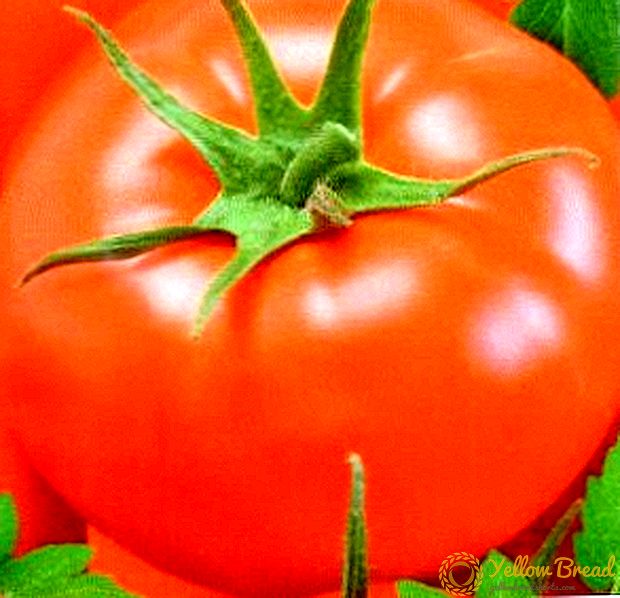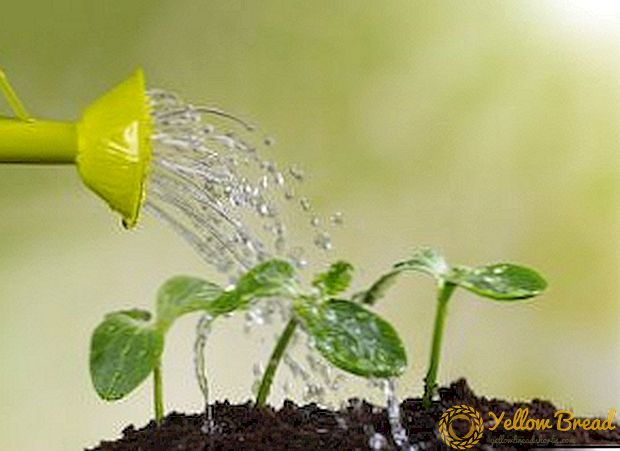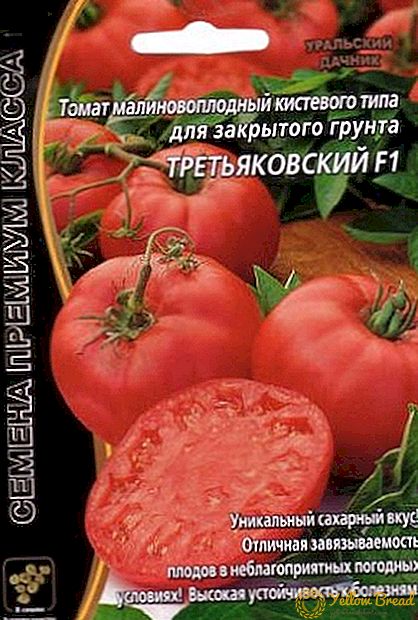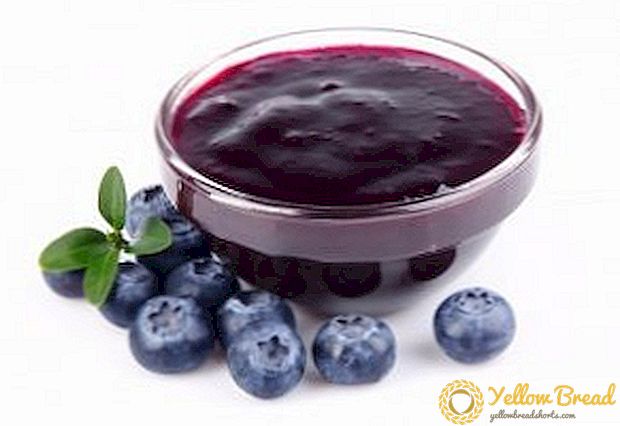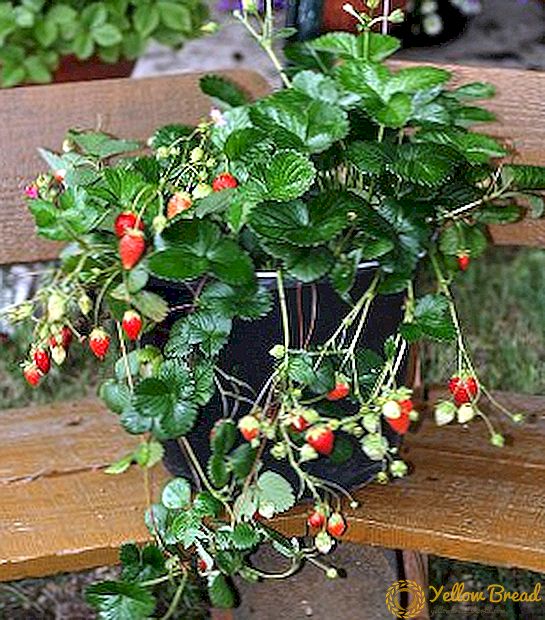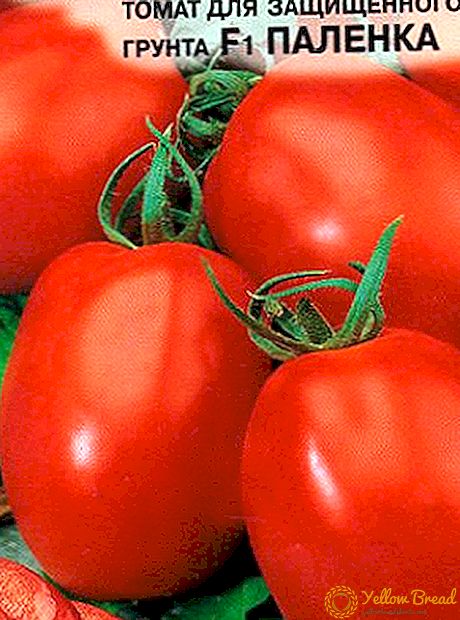 Tomato is one of the most popular products in the world. It can be bought in the supermarket all year round, and in the season on the market.
Tomato is one of the most popular products in the world. It can be bought in the supermarket all year round, and in the season on the market.
Only here it is much more pleasant to grow a tomato with your own hands. You can do this both in the open field and in the greenhouse.
One of the popular varieties for protected ground is the tomato "Palenka".
- Description "Palenki"
- Bushes
- Fruit
- Characteristic variety
- Advantages and disadvantages
- How to plant tomatoes?
- Terms and scheme of sowing seeds
- Transplanting seedlings
- Tomato care
- Diseases and pests
Description "Palenki"
Tomatoes "Palenka" medium term ripening. Grown on protected ground or in greenhouses.
Bushes
The bush is represented by one stem, which requires binding, as the variety is indeterminate. The height of the bush can reach 180 cm, and on average - about 160 cm. The stalk is powerful, without branches. Requires mandatory pinching. The leaves are rounded, pointed, medium size. Their color is bright green. Fruiting on the bush carpus. The first brush - around the ninth sheet. 
Fruit
On fruit brushes about 6 tomatoes are formed.Fruit shape - smooth oval "cream". At full maturity, the color is bright red. It has excellent taste, slightly sour. The average weight of the fruit is about 100 g. The presentation is excellent, transported without problems. It has a good keeping quality.
The fruits are universal in use. Good fresh, suitable for harvesting for the winter. Can be preserved and salted in the whole form. They also make excellent preparations: juice, sauces, ketchup, salads, etc.
Characteristic variety
In the description of the tomato "Palenka" the following are indicated characteristics and qualities gradebut:
- Variety "Palenka" is a hybrid of the first generation, therefore, is labeled as F1.
- This is an indeterminate tomato for growing on protected grounds or in greenhouses.
- It has medium early ripening. Only 105-115 days pass from sprouts of seedlings to the first mature fruits.
- Fruiting carpus. Brush - about 6 fruits, 80-100 g each.
- The first fruit clusters are located above the 9th leaf, then - every 2-3 leaves.
- Productivity of tomato "Palenka" is high. From 1 square.m can collect up to 20 kg of tomatoes.
- Requires binding and pinching.
- It is universal in application: use in raw form, preparations for the winter, good for sale.

Advantages and disadvantages
Like any crop, the Palenka variety has a number of advantages and disadvantages.
Advantages:
- grown in any climatic zone;
- unpretentious;
- fruits are even, uniform;
- high yield;
- excellent taste;
- universal in use;
- suitable for canning in general;
- excellent presentation;
- good logging;
- resistant to transport.
Among the shortcomings noted the following:
- requires tying up;
- requires staving;
- not grown in open field;
- unstable to phytophthora and other diseases of tomatoes.
How to plant tomatoes?
Like almost all varieties of tomatoes, tomatoes "Palenka F1" are grown in a seedling way. 
Terms and scheme of sowing seeds
Seed is planted in March, approximately 10th. Before planting, we need some preparation of the soil and the seeds themselves.
The soil for seedlings need mixed, consisting of turf land, humus and sand in a ratio of 2: 2: 1. It must be decontaminated by spilling with a weak solution of potassium permanganate or by heating in the oven for 15-20 minutes.
For seeds, it is also possible to carry out decontamination with a solution of manganese and place them in wet gauze for a day.
It is necessary to plant the seeds in a warm moist soil, immersing them in the soil by 1 cm. Planting pattern: in a row - in 3-4 cm, between rows - about 8-10 cm.
Having covered the grains with earth, do not slap it. Next, cover with film or glass, place in a warm, well-lit place and do not disturb before germination. After the sprout appears, remove the film and provide the plants with proper care.  Seedlings are very light and heat-loving. If natural lighting is not enough, then you need to take care of artificial. If you keep the seedlings in a shaded or dark place, the sprouts will turn into "strings" and lose stability and strength.
Seedlings are very light and heat-loving. If natural lighting is not enough, then you need to take care of artificial. If you keep the seedlings in a shaded or dark place, the sprouts will turn into "strings" and lose stability and strength.
Watering requires moderate but regular. Before the appearance of two leaves, it is better to moisten the soil with a spray gun, in order to avoid the appearance of a crust.When sprout grow up and have two leaves, you can water at the root, with the appearance of a peel - loosen the soil.
Seedlings definitely need to stop with the advent of the third sheet. After cupping, feed with complex fertilizer.
Transplanting seedlings
It is necessary to transplant seedlings in the greenhouse two weeks after the dive. At that time, it should have 4-5 leaves, a steady stalk and a strong root. The layout of seedlings traditional for greenhouses - 50×50 or 4 plants per 1 square. m
Tomato care
Caring for tomatoes planted in the greenhouse is simple for an experienced gardener. It is provided by watering, fertilizing, tying up, staving, prevention of diseases and pests.
Watering should be moderate, with a slight drying of the topsoil.
As soon as the stem begins to bend the top, you need to start tying. In the greenhouse it is better to do this with the help of tapestries.
When fruit brushes appear and fruits begin to fill, they also need to be tied up in order to avoid breaking off the stem and the brushes themselves.
Passy need to need.Break off stepchildren at once, without waiting for when they grow up.
After planting, it is necessary to feed plants with phosphate fertilizer, and with the appearance of flowers and the first fruits - potash fertilizer. You can use complex fertilizers. 
Diseases and pests
Among plant diseases for the variety “Palenka”, late blight, mosaic, and brown spot are common. It is important to produce timely prevention, and in case of illness - the treatment of the plant.
Spider mites, scoops, wireworms, etc. can harm tomatoes.
Prevention and treatment of tomatoes produced by means acquired in a specialty store.
To grow tomatoes "Palenka" in the greenhouse is easy. This variety will delight you with high yield, delicious fresh tomatoes and blanks for the winter.


